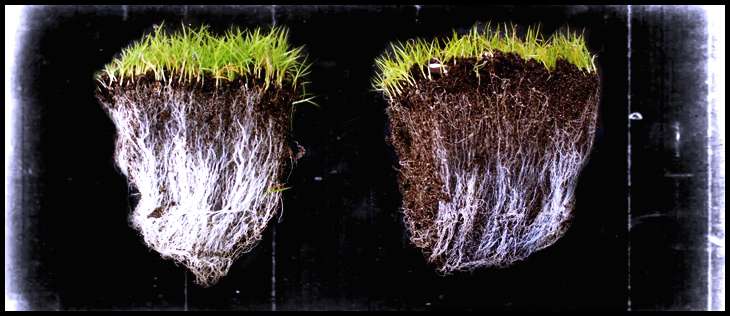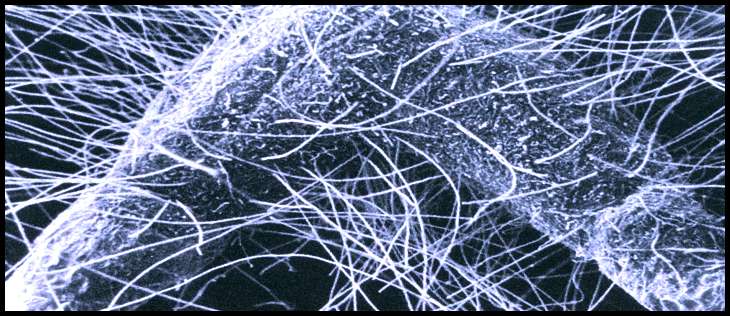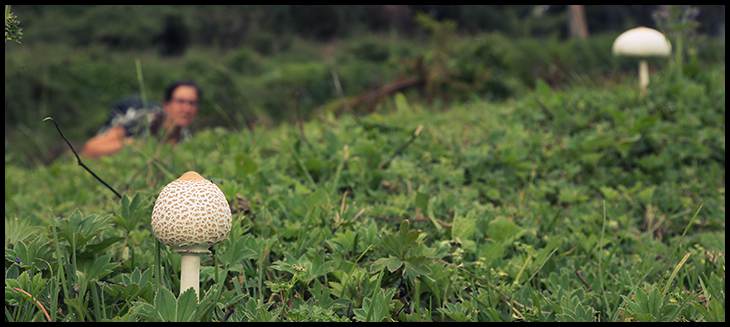How do mycorrhizae work?
Have you ever had to work in a garden, or even just grow a single plant? If so, you know it’s hard work—you have to carefully cultivate growth by keeping the weeds at bay and providing the plant with plenty of water and sunshine. At the end, you’re rewarded with an abundance of healthy nutrients in the form of delicious, fresh vegetables or a view of beautiful flowers. But did you know that many plants have their own gardens too? Unlike our gardens, though, the plant’s gardens are entirely underground, and normally you’d never see them except for a brief period each year. They’re called mycorrhizae (my-coh-rise-eh), and they live in a symbiotic relationship with the plant itself.
What are mycorrhizae?
Mycorrhizae are actually a fungus. They exist as very tiny, almost or even entirely microscopic, threads called hyphae. The hyphae are all interconnected into a net-like web called a mycelium, which measures hundreds or thousands of miles—all packed into a tiny area around the plant.
The mycelium of a single mycorrhiza (note: mycorrhizae is plural), in turn, can extend outward, connect multiple plants (even plants of different species!), and even connect with other mycorrhizae to form a Frankenstein-like underground mash-up called a common mycorrhizal network.

In a common mycorrhizal network, it’s hard to tell where one mycorrhiza ends and another begins. Because of this vast network, a single plant can be connected to a completely different species of plant halfway across a forest!
Mycorrhizae actually connect to plants in two ways. One form, called ectomycorrhizae, simply surrounds the outside of the roots. Another form, called endomycorrhizae, actually grows inside of the plant—their hyphae squeeze in between the cell wall and the cell membranes of the roots (sort of like wedging themselves in between a bicycle tire and the inner tube).
Under normal conditions, you’re not likely to see mycorrhizae because they’re so small. But every once in a while, something amazing happens: the mycorrhizae will reproduce and send up fruiting bodies that produce spores—we call them mushrooms! Some of these mushrooms are even edible, like truffles or chanterelles.
How do plants help mycorrhizae?
Plants make great gardeners. Just like we fertilize our gardens, plants feed their own mycorrhizae. Plants will take excess sugar produced in the leaves through photosynthesis and send it to the roots. From here, the mycorrhizae are able to absorb it to sustain themselves. There is very little sunlight underground, and even if there was, the mycorrhizae wouldn’t be able to harvest it like plants because they don’t have the equipment needed for photosynthesis. The sugar from the plants literally keeps the mycorrhizae fed and alive.
How do mycorrhizae help plants?
Plants don’t give up their valuable sugar resources just for the fun of growing fungus gardens. They get a lot of things in return from the mycorrhizae, mostly in the form of nutrients.
Plants are able to get nutrients themselves through their roots, but they have a limited ability to do so. Their roots need to be in direct contact with the soil to absorb the nutrients, and plant roots only grow so small. Fungi, on the other hand, can get much smaller. Fungal hyphae can wedge in between individual bits of soil to cover almost every available cubic millimeter of soil. This increases surface area and allows the plants much greater access to nutrients than they could get by themselves. For many plants living under difficult conditions, they wouldn’t be able to survive at all without mycorrhizae.
The mycorrhizae absorb nutrients such as phosphorus and magnesium and bring it directly to the plant roots. Here, they exchange the nutrients they’ve collected for some sugar. It’s a fair trade, and both sides benefit.
Additionally, the mycorrhizae help plants out in a whole bunch of other ways. Mycorrhizae can help protect their plants against diseases and toxins. Mycorrhizae can also serve as a sugar delivery service when plants shuttle sugar back and forth to different plants connected to the same common mycorrhizal network. Perhaps most bizarrely of all, the common mycorrhizal network can also serve as a means for plants to “talk” to each other—an Internet made out of fungus!

Putting It All Together
Mycorrhizae form an invaluable part of ecosystems around the world, and can be found in some form or another in just about any ecosystem. In many places, whole forests and ecosystems wouldn’t exist at all without their mycorrhizal friends.
The next time you’re walking in a forest and you see a mushroom growing out of the ground, be thankful and remember that there’s a whole world buzzing along beneath your feet.
Related Topics
Have you ever had to work in a garden, or even just grow a single plant? If so, you know it’s hard work—you have to carefully cultivate growth by keeping the weeds at bay and providing the plant with plenty of water and sunshine. At the end, you’re rewarded with an abundance of healthy nutrients in the form of delicious, fresh vegetables or a view of beautiful flowers. But did you know that many plants have their own gardens too? Unlike our gardens, though, the plant’s gardens are entirely underground, and normally you’d never see them except for a brief period each year. They’re called mycorrhizae (my-coh-rise-eh), and they live in a symbiotic relationship with the plant itself.
What are mycorrhizae?
Mycorrhizae are actually a fungus. They exist as very tiny, almost or even entirely microscopic, threads called hyphae. The hyphae are all interconnected into a net-like web called a mycelium, which measures hundreds or thousands of miles—all packed into a tiny area around the plant.
The mycelium of a single mycorrhiza (note: mycorrhizae is plural), in turn, can extend outward, connect multiple plants (even plants of different species!), and even connect with other mycorrhizae to form a Frankenstein-like underground mash-up called a common mycorrhizal network.

In a common mycorrhizal network, it’s hard to tell where one mycorrhiza ends and another begins. Because of this vast network, a single plant can be connected to a completely different species of plant halfway across a forest!
Mycorrhizae actually connect to plants in two ways. One form, called ectomycorrhizae, simply surrounds the outside of the roots. Another form, called endomycorrhizae, actually grows inside of the plant—their hyphae squeeze in between the cell wall and the cell membranes of the roots (sort of like wedging themselves in between a bicycle tire and the inner tube).
Under normal conditions, you’re not likely to see mycorrhizae because they’re so small. But every once in a while, something amazing happens: the mycorrhizae will reproduce and send up fruiting bodies that produce spores—we call them mushrooms! Some of these mushrooms are even edible, like truffles or chanterelles.
How do plants help mycorrhizae?
Plants make great gardeners. Just like we fertilize our gardens, plants feed their own mycorrhizae. Plants will take excess sugar produced in the leaves through photosynthesis and send it to the roots. From here, the mycorrhizae are able to absorb it to sustain themselves. There is very little sunlight underground, and even if there was, the mycorrhizae wouldn’t be able to harvest it like plants because they don’t have the equipment needed for photosynthesis. The sugar from the plants literally keeps the mycorrhizae fed and alive.
How do mycorrhizae help plants?
Plants don’t give up their valuable sugar resources just for the fun of growing fungus gardens. They get a lot of things in return from the mycorrhizae, mostly in the form of nutrients.
Plants are able to get nutrients themselves through their roots, but they have a limited ability to do so. Their roots need to be in direct contact with the soil to absorb the nutrients, and plant roots only grow so small. Fungi, on the other hand, can get much smaller. Fungal hyphae can wedge in between individual bits of soil to cover almost every available cubic millimeter of soil. This increases surface area and allows the plants much greater access to nutrients than they could get by themselves. For many plants living under difficult conditions, they wouldn’t be able to survive at all without mycorrhizae.
The mycorrhizae absorb nutrients such as phosphorus and magnesium and bring it directly to the plant roots. Here, they exchange the nutrients they’ve collected for some sugar. It’s a fair trade, and both sides benefit.
Additionally, the mycorrhizae help plants out in a whole bunch of other ways. Mycorrhizae can help protect their plants against diseases and toxins. Mycorrhizae can also serve as a sugar delivery service when plants shuttle sugar back and forth to different plants connected to the same common mycorrhizal network. Perhaps most bizarrely of all, the common mycorrhizal network can also serve as a means for plants to “talk” to each other—an Internet made out of fungus!

Putting It All Together
Mycorrhizae form an invaluable part of ecosystems around the world, and can be found in some form or another in just about any ecosystem. In many places, whole forests and ecosystems wouldn’t exist at all without their mycorrhizal friends.
The next time you’re walking in a forest and you see a mushroom growing out of the ground, be thankful and remember that there’s a whole world buzzing along beneath your feet.

































































































